Related Research Articles
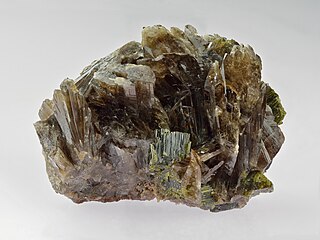
Axinite is a brown to violet-brown, or reddish-brown bladed group of minerals composed of calcium aluminium boro-silicate, (Ca,Fe,Mn)3Al2BO3Si4O12OH. Axinite is pyroelectric and piezoelectric.
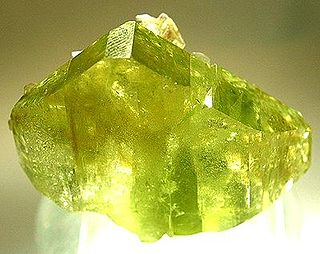
Brazilianite, whose name derives from its country of origin, Brazil, is a typically yellow-green phosphate mineral, most commonly found in phosphate-rich pegmatites.

Hausmannite is a complex oxide, or a mixed oxide, of manganese containing both di- and tri-valent manganese. Its chemical formula can be represented as MnIIMnIII2O4, or more simply noted as MnO·Mn2O3, or Mn3O4, as commonly done for magnetite, the corresponding iron oxide. It belongs to the spinel group and forms tetragonal crystals. Hausmannite is a brown to black metallic mineral with Mohs hardness of 5.5 and a specific gravity of 4.8.
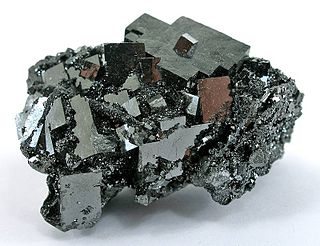
Bixbyite is a manganese iron oxide mineral with chemical formula: (Mn,Fe)2O3. The iron/manganese ratio is quite variable and many specimens have almost no iron. It is a metallic dark black with a Mohs hardness of 6.0 – 6.5. It is a somewhat rare mineral sought after by collectors as it typically forms euhedral isometric crystals exhibiting various cubes, octahedra, and dodecahedra.
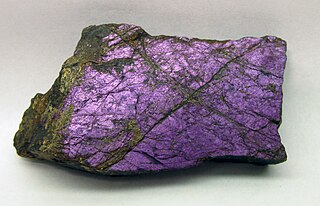
Purpurite is a manganese phosphate mineral with the formula MnPO4, with varying amounts of iron depending upon its source. It occurs in color ranges from brownish black via purple and violet to dark red.

Eosphorite is a brown (occasionally pink) manganese hydrous phosphate mineral with chemical formula: MnAl(PO4)(OH)2·H2O. It is used as a gemstone.

Arthurite is a mineral composed of divalent copper and iron ions in combination with trivalent arsenate, phosphate and sulfate ions with hydrogen and oxygen. Initially discovered by Sir Arthur Russell in 1954 at Hingston Down Consols mine in Calstock, Cornwall, England, arthurite is formed as a resultant mineral in the oxidation region of some copper deposits by the variation of enargite or arsenopyrite. The chemical formula of Arthurite is CuFe23+(AsO4,PO4,SO4)2(O,OH)2·4H2O.
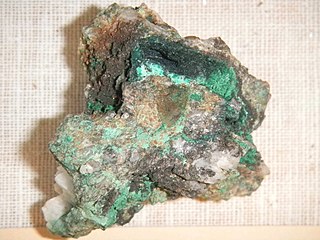
Lipscombite (Fe2+,Mn2+)(Fe3+)2(PO4)2(OH)2 is a green gray, olive green, or black. phosphate-based mineral containing iron, manganese, and iron phosphate.

Shigaite is a mineral with formula NaAl3(Mn2+)6(SO4)2(OH)18·12H2O that typically occurs as small, hexagonal crystals or thin coatings. It is named for Shiga Prefecture, Japan, where it was discovered in 1985. The formula was significantly revised in 1996, identifying sodium as a previously unknown constituent.
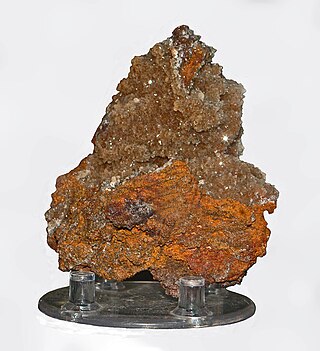
Tarbuttite is a rare phosphate mineral with formula Zn2(PO4)(OH). It was discovered in 1907 in what is now Zambia and named for Percy Coventry Tarbutt.
Arsenoclasite (originally arsenoklasite) is a red or dark orange brown mineral with formula Mn5(AsO4)2(OH)4. The name comes from the Greek words αρσενικόν (for arsenic) and κλάσις (for cleavage), as arsenoclasite contains arsenic and has perfect cleavage. The mineral was discovered in 1931 in Långban, Sweden.

Sarkinite, synonymous with chondrarsenite and polyarsenite, is a mineral with formula Mn2(AsO4)(OH). The mineral is named for the Greek word σάρκιυος, meaning made of flesh, for its red color and greasy luster. The mineral was first noted in Sweden in 1865 as chondrarsenite, though not identified as sarkinite until 1885.

Ferrogedrite is an amphibole mineral with the complex chemical formula of ☐Fe2+2(Fe2+3Al2)(Si6Al2)O22(OH)2. It is sodium and calcium poor, making it part of the magnesium-iron-manganese-lithium amphibole subgroup. Defined as less than 1.00 apfu (atoms per formula unit) of Na + Ca and consisting of greater than 1.00 apfu of (Mg, Fe2+, Mn2+, Li) separating it from the calcic-sodic amphiboles. It is related to anthophyllite amphibole and gedrite through coupled substitution of (Al, Fe3+) for (Mg, Fe2+, Mn) and Al for Si. and determined by the content of silicon in the standard cell.

Hidalgoite, PbAl3(AsO4)(SO4)(OH)4, is a rare member of the beudantite group and is usually classified as part of the alunite family. It was named after the place where it was first discovered, the Zimapán mining district, Hidalgo, Mexico. At Hidalgo where it was initially discovered, it was found as dense white masses in alternating dikes of quartz latite and quartz monzonite alongside other secondary minerals such as sphalerite, arsenopyrite, cerussite and trace amounts of angelsite and alamosite, it was then rediscovered at other locations such as Australia where it occurs on oxidized shear zones above greywacke shales especially on the anticline prospects of the area, and on fine grained quartz-spessartine rocks in Broken Hill, Australia. Hidalgoite specimens are usually associated with copper minerals, clay minerals, iron oxides and polymetallic sulfides in occurrence.
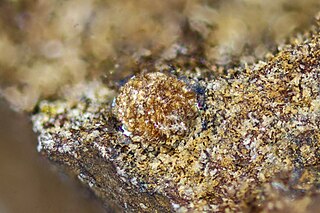
Waterhouseite, Mn7(PO4)2(OH)8, is a hydroxy manganese phosphate mineral. It is a medium-soft, brittle mineral occurring in pseudo-orthorhombic monoclinic bladed crystals and orange-brown to dark brown in color. Waterhouseite is on the softer side with a Mohs hardness of 4, has a specific gravity of 3.5 and a yellowish-brown streak. It is named after Frederick George Waterhouse, first director of the South Australian Museum, as well as recognizes the work Waterhouse Club has done in support of the South Australian Museum.
Szklaryite is an extremely rare mineral with the formula []Al6BAs33+O15. It is essentially vacant ("[]"), arsenic-dominant member of dumortierite supergroup, giving a name of szklaryite group. It is one of three quite recently found minerals of this group, the other two being nioboholtite and titanoholtite, all coming from the Szklary village near Ząbkowice Śląskie in Poland. They occur in a unique pegmatite of probable anatectic origin.

Segnitite is a lead iron(III) arsenate mineral. Segnitite was first found in the Broken Hill ore deposit in Broken Hill, New South Wales, Australia. In 1991, segnitite was approved as a new mineral. Segnitite has since been found worldwide near similar locality types where rocks are rich in zinc and lead especially. it was named for Australian mineralogist, gemologist and petrologist Edgar Ralph Segnit. The mineral was named after E. R. Segnit due to his contributions to Australian mineralogy.

Strunzite (Mn2+Fe3+2(PO4)2(OH)2 · 6H2O) is a light yellow mineral of the strunzite group, first discovered in 1957.

Kidwellite in an uncommon mineral that was discovered in Arkansas in the United States. It was approved by the IMA in 1974, but it was only named in 1978 by Moore and Ito after Albert Lewis (Laws) Kidwell.
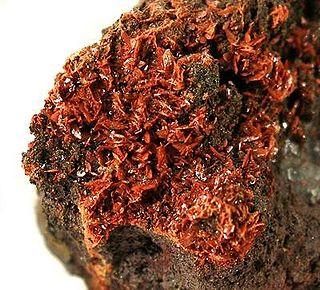
Mawbyite is a lead iron zinc arsenate that was named in honor of Maurice Alan Edgar Mawby. It has been approved by the IMA in 1988, and was published just a year after being described by Pring. Mawbyite is a member of the tsumcorite group, the monoclinic dimorph of carminite. It was first believed to be tsumcorite; however, crystal-structure determination showed iron and zinc occupying the same crystallographic site instead, and through the analysis it turned out mawbyite is isostructural with tsumcorite, meaning the two share a similar formula. More accurately, mawbyite appears to be the ferric analogue of the aforementioned mineral. The relationship between helmutwinklerite – which shares a similar formula with tsumcorite's – and mawbyite had been suggested, but due to lack of data it remains unclear. A full crystal-structure analysis is required in order to understand the relationship between their structures.
References
- 1 2 3 4 5 6 7 8 9 "Gatehouseite". Mindat. Retrieved May 22, 2012.
- ↑ Warr, L.N. (2021). "IMA–CNMNC approved mineral symbols". Mineralogical Magazine. 85 (3): 291–320. Bibcode:2021MinM...85..291W. doi: 10.1180/mgm.2021.43 . S2CID 235729616.
- 1 2 3 4 5 6 7 8 9 10 11 12 "Gatehouseite" (PDF). Handbook of Mineralogy. Mineral Data Publishing. Retrieved May 22, 2012.
- 1 2 3 4 Elliott & Pring 2011, p. 2823.
- 1 2 Pring & Birch 1993, p. 309.
- 1 2 3 4 5 6 Pring & Birch 1993, p. 310.
Bibliography
- Elliott, P.; Pring, A. (2011). "The crystal structure of gatehouseite" . Mineralogical Magazine. 75 (6). The Mineralogical Society: 2823–2832. Bibcode:2011MinM...75.2823.. doi:10.1180/minmag.2011.075.6.2823. S2CID 99885696 . Retrieved May 23, 2012.(subscription required)
- Pring, A.; Birch, W.D. (1993). "Gatehouseite, a New Manganese Hydroxy Phosphate from Iron Monarch, South Australia" (PDF). Mineralogical Magazine. 57 (387). The Mineralogical Society: 309–313. Bibcode:1993MinM...57..309P. doi:10.1180/minmag.1993.057.387.13. S2CID 140568230. Archived from the original (PDF) on May 27, 2016. Retrieved May 22, 2012.